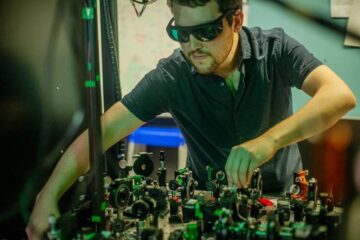How living matter self-organizes through chemical signals

Mixtures of producer and consumer particles can self-organize in many ways. From left to right: formation of small self-propelled molecules composed of just a few particles; complete separation of producers and consumers into distinct clusters; aggregation into a static cluster with precise composition; aggregation into a self-propelled comet-like cluster. © MPIDS
Sensing each other through chemistry
Combining theory and computer simulations, the researchers studied the behaviour of mixtures of different particle species, which produce or consume a chemical signal to which they may in turn be attracted or repelled.
Depending on the characteristics of each species, as well as on the ratios in which the species are mixed, they found that the particles will spontaneously aggregate together or separate in a myriad of different configurations.
Mixtures of one producer species and one consumer species, for example, may completely separate into two distinct clusters under certain conditions, but under different conditions they may aggregate together into a cluster with a precisely defined composition. Even more spectacularly, these clusters may spontaneously start self-propelling in a comet-like fashion, with a close-packed group of producers being chased by a tail of consumers, or vice versa.
Breaking Newton’s third law
Indeed, according to Agudo-Canalejo and Golestanian, a peculiarity of these chemical-mediated interactions is that they effectively break Newton's third law of equal action and reaction: for example, a particle of one species may be attracted to a particle of the other species, but the second one may be repelled from the first one, so that one particle ends up chasing the other.
These and other peculiarities are a direct consequence of the chemical activity that characterizes living matter, and are responsible for the richness of the self-organization phenomena observed, which would be absent in a non-living system.
“We expect that our minimal model may be applied to a variety of problems in biology and engineering. The self-propelling clusters observed, for example, may be relevant to understand mechanisms of collective migration of cells or microorganisms in heterogeneous tissues or colonies. On a much smaller scale inside the cell, the model may explain why enzymes that participate in common catalytic pathways tend to co-localize, an observation that until now had no generic explanation,” says Jaime Agudo-Canalejo, first author of the study.
MPI director Ramin Golestanian adds: “We also envisage applications in the engineering of active materials, which may spontaneously assemble from synthetic particles that catalyze chemical reactions.”
Media Contact
More Information:
http://www.ds.mpg.de/3426119/190619_pm_prl_agudo_canalejoAll latest news from the category: Physics and Astronomy
This area deals with the fundamental laws and building blocks of nature and how they interact, the properties and the behavior of matter, and research into space and time and their structures.
innovations-report provides in-depth reports and articles on subjects such as astrophysics, laser technologies, nuclear, quantum, particle and solid-state physics, nanotechnologies, planetary research and findings (Mars, Venus) and developments related to the Hubble Telescope.
Newest articles

Combatting disruptive ‘noise’ in quantum communication
In a significant milestone for quantum communication technology, an experiment has demonstrated how networks can be leveraged to combat disruptive ‘noise’ in quantum communications. The international effort led by researchers…

Stretchable quantum dot display
Intrinsically stretchable quantum dot-based light-emitting diodes achieved record-breaking performance. A team of South Korean scientists led by Professor KIM Dae-Hyeong of the Center for Nanoparticle Research within the Institute for…

Internet can achieve quantum speed with light saved as sound
Researchers at the University of Copenhagen’s Niels Bohr Institute have developed a new way to create quantum memory: A small drum can store data sent with light in its sonic…





















